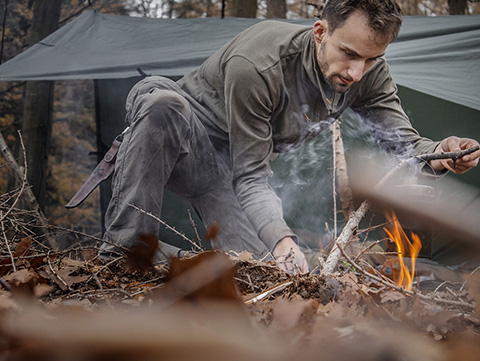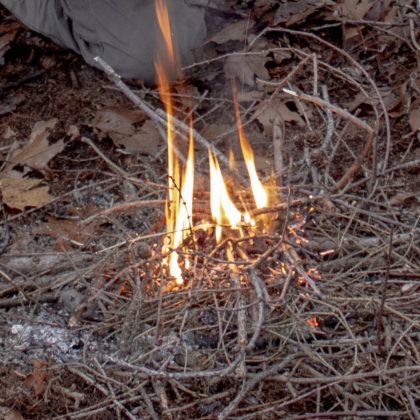
Koen does bushcraft
Dependent on nature
It’s five o’clock in the morning, and it’s three degrees Celsius outside. The fire has gone out, everything on the ground is wet. In the distance, a deer grunts. RUG student Koen van Steenbeek is asleep in his sleeping bag in between the trees. It’s his home for the weekend.
Not because he’s a student in need of housing; he has a comfortable room near the city centre. He’s spending the weekend in the woods for fun. ‘I’m going back to basics.’
Koen does bushcraft. It’s not the same as wilderness survival, he says. ‘It’s not about trying to survive or making life hard for yourself. We do more than just forage for food.’ Bushcraft is aimed at people who enjoy living in nature without technology, who like making things, such as your own drying rack, a tinder box, traps, or knife sheath.
Wonder
‘At home we tend to be sort of disconnected from the rest of the world’, says Koen. ‘Here, you’re completely dependent upon nature: where do I find shelter, what will I eat, what will the weather be like? You can’t just sit back with a bag of crisps and watch tv. Not that that’s not fun, but this is fun, too.’
You can’t just sit back with a bag of crisps
As a little kid he wanted to be a Boy Scout, ‘but there was an enormous waiting list’. He didn’t make the cut. A few years ago, though, he saw Miriam and Peter Lancewood on television. They were trekking through the wilderness in New Zealand, mainly living off what they could find. ‘I wanted to know how I could learn to do that.’
His interest in nature comes from a sense of wonder, he says. ‘The complexity of it, the variety, its capriciousness and beauty. How it came into existence without any defined plan.’
Making camp

Making fire
Koen clears a patch of ground of leaves and makes sure he has enough firewood, ranging from small twigs to thick branches. He makes a fire bed by placing approximately five pieces of kindling next to each other. He uses a firestick to light three cotton pads, which he’s picked apart and turned into a fuzzy ball, adding oxygen. The next day, he uses dried grass instead of cotton pads, since that works just as well. ‘The more you do it, the easier it becomes.’
A basha – a kind of tarpaulin – a mat, and a well-isolated sleeping bag; it’s all that Koen needs to make his camp in bleak autumn weather. The basha is suspended between two trees. On the side where the wind hits it, it’s been pulled down to the ground; any gaps have been filled up with leaves. On the other side, Koen is turning the tarpaulin into a shelter, using a few sticks as tent poles. It takes him a little over half an hour, but then he’s also made a fire pit.
Bushcraft instructor René Nauta nods approvingly when he hears about it on the first night. Koen and his eight fellow bushcraft students are standing in the chute, a tepee-like tent made out of parachute silk. Some of them are sitting on camping chairs. A fire burns in the middle of the circle. Dog Sjunka walks among the students, wagging her tail, looking for someone to throw a stick.
It’s a diverse group, ranging from IT specialists to psychologists, and they’re from all over the country. This time around, the group consist of only men, since the two women who’d signed had to cancel. Owner and instructor Beke Olbers is also missing, since she’s teaching a course in making leather shoes.
Tracking
Lit by the new moon, the nine men take rakes and forks into the woods. The cold slowly grows worse as fog creeps across the heath. The men loosen up the sand on a path so they’ll be able to identify animal tracks the next morning.
On the way back, the instructor teaches them to recognise dead branches in the forest. A little bit later, Koen enters the camp with his arms full of firewood. Warmed by the fire, he retires to his sleeping bag, which lies on a mat and a bed of wet leaves. He’s not afraid of animals invading his little camp. ‘I’ll find a bug in my sleeping bag sometimes, but I’m usually pretty well insulated.’
Make a cross out of sticks to show where your poop is so you don’t end up digging it up later
So where do you poop? ‘Ah, yes’, Koen says, grinning. ‘In the poop woods.’ Here’s how it works: you go to the designated area in the woods and dig a hole with a shovel specifically designed for this. You do your thing, wipe – either with toilet paper or with dried leaves – cover up the hole, and burn the paper. And don’t forget: ‘Use some sticks to make a cross where your poop is.’ This is to make sure no one else accidentally digs it up later.
Doubt
The next morning, after they had a look at the animal tracks on the sandy path, Koen prepares his breakfast over a fire: oatmeal with raisins and nuts. He adds some wood to the fire, blows on it, adds some more wood. The flames lick his home-made billycan, his cooking pot. The oatmeal bubbles in the water. ‘At home I eat it cold, with milk.’ Unfortunately, he has no milk here.
‘I’m focused on nature in a very real way here’, says Koen. That’s exactly why it’s so different from his studies in molecular life sciences. That’s about nature as well, but it’s focused on the smallest parts of life, in a lab, far away from real nature.
It’s led him to doubt his choice of studies. ‘Do I really want to spend ten years focusing on just one tiny part of a cell? I like to see real results, to know why I do something. For instance, how we can grow soy in the Netherlands so we don’t have to ship it from South America anymore. That requires a lot of knowledge on the molecular level.’
Killing animals
Today, he’s making a mouse trap. It’s a falling trap made of four sticks and a small wire container, which means the trap is not deadly. The instructor explains that you can also make it bigger and use a tree trunk instead of a container. Any animal activating the trap would not survive.
We catch animals who had a good life. It’s no worse than meat from the supermarket
However, that would amount to poaching, and that’s illegal in the Netherlands. It’s fine in Scotland, which is where the group stayed last year in June, in a large national park. ‘That was really cool’, says Koen. ‘We set wire traps and fish traps in a stream.’ They’d made the fish traps out of withy.
Koen didn’t catch any fish in his trap. But the group did catch a sea bass with their trawl, and a hunter who’d shot a deer nearby provided them with three days’ worth of food.
Koen knows that killing animals is a sensitive issue. ‘But I think it’s less sad than killing animals who’ve been raised in the bio-industry. We catch animals who had a good life in nature. It’s no worse than the meat you buy in the supermarket.’
On the last day, Koen and his fellow students use wood from the forest and a store-bought tendon to make a bow and arrow. ‘You can also make the string out of stinging nettle fibres’, says Koen. But ‘everything you make takes time’, and this weekend is too short for stinging nettles strings. The store-bought string meant he could practise shooting by the end of the day. His target: tree trunks.


